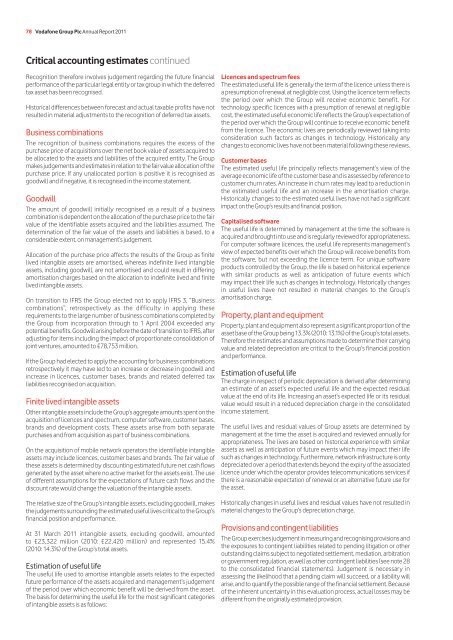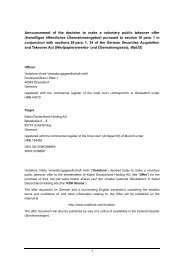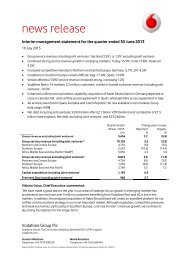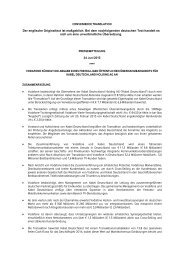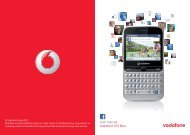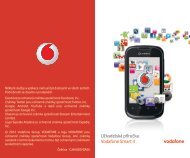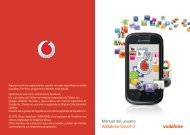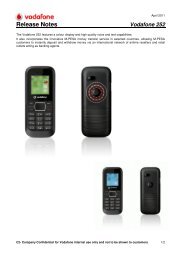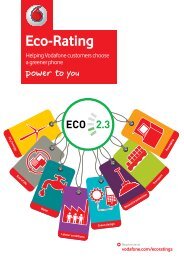Download the report - Vodafone
Download the report - Vodafone
Download the report - Vodafone
Create successful ePaper yourself
Turn your PDF publications into a flip-book with our unique Google optimized e-Paper software.
78 <strong>Vodafone</strong> Group Plc Annual Report 2011<br />
Critical accounting estimates continued<br />
Recognition <strong>the</strong>refore involves judgement regarding <strong>the</strong> future financial<br />
performance of <strong>the</strong> particular legal entity or tax group in which <strong>the</strong> deferred<br />
tax asset has been recognised.<br />
Historical differences between forecast and actual taxable profits have not<br />
resulted in material adjustments to <strong>the</strong> recognition of deferred tax assets.<br />
Business combinations<br />
The recognition of business combinations requires <strong>the</strong> excess of <strong>the</strong><br />
purchase price of acquisitions over <strong>the</strong> net book value of assets acquired to<br />
be allocated to <strong>the</strong> assets and liabilities of <strong>the</strong> acquired entity. The Group<br />
makes judgements and estimates in relation to <strong>the</strong> fair value allocation of <strong>the</strong><br />
purchase price. If any unallocated portion is positive it is recognised as<br />
goodwill and if negative, it is recognised in <strong>the</strong> income statement.<br />
Goodwill<br />
The amount of goodwill initially recognised as a result of a business<br />
combination is dependent on <strong>the</strong> allocation of <strong>the</strong> purchase price to <strong>the</strong> fair<br />
value of <strong>the</strong> identifiable assets acquired and <strong>the</strong> liabilities assumed. The<br />
determination of <strong>the</strong> fair value of <strong>the</strong> assets and liabilities is based, to a<br />
considerable extent, on management’s judgement.<br />
Allocation of <strong>the</strong> purchase price affects <strong>the</strong> results of <strong>the</strong> Group as finite<br />
lived intangible assets are amortised, whereas indefinite lived intangible<br />
assets, including goodwill, are not amortised and could result in differing<br />
amortisation charges based on <strong>the</strong> allocation to indefinite lived and finite<br />
lived intangible assets.<br />
On transition to IFRS <strong>the</strong> Group elected not to apply IFRS 3, “Business<br />
combinations”, retrospectively as <strong>the</strong> difficulty in applying <strong>the</strong>se<br />
requirements to <strong>the</strong> large number of business combinations completed by<br />
<strong>the</strong> Group from incorporation through to 1 April 2004 exceeded any<br />
potential benefits. Goodwill arising before <strong>the</strong> date of transition to IFRS, after<br />
adjusting for items including <strong>the</strong> impact of proportionate consolidation of<br />
joint ventures, amounted to £78,753 million.<br />
If <strong>the</strong> Group had elected to apply <strong>the</strong> accounting for business combinations<br />
retrospectively it may have led to an increase or decrease in goodwill and<br />
increase in licences, customer bases, brands and related deferred tax<br />
liabilities recognised on acquisition.<br />
Finite lived intangible assets<br />
O<strong>the</strong>r intangible assets include <strong>the</strong> Group’s aggregate amounts spent on <strong>the</strong><br />
acquisition of licences and spectrum, computer software, customer bases,<br />
brands and development costs. These assets arise from both separate<br />
purchases and from acquisition as part of business combinations.<br />
On <strong>the</strong> acquisition of mobile network operators <strong>the</strong> identifiable intangible<br />
assets may include licences, customer bases and brands. The fair value of<br />
<strong>the</strong>se assets is determined by discounting estimated future net cash flows<br />
generated by <strong>the</strong> asset where no active market for <strong>the</strong> assets exist. The use<br />
of different assumptions for <strong>the</strong> expectations of future cash flows and <strong>the</strong><br />
discount rate would change <strong>the</strong> valuation of <strong>the</strong> intangible assets.<br />
The relative size of <strong>the</strong> Group’s intangible assets, excluding goodwill, makes<br />
<strong>the</strong> judgements surrounding <strong>the</strong> estimated useful lives critical to <strong>the</strong> Group’s<br />
financial position and performance.<br />
At 31 March 2011 intangible assets, excluding goodwill, amounted<br />
to £23,322 million (2010: £22,420 million) and represented 15.4%<br />
(2010: 14.3%) of <strong>the</strong> Group’s total assets.<br />
Estimation of useful life<br />
The useful life used to amortise intangible assets relates to <strong>the</strong> expected<br />
future performance of <strong>the</strong> assets acquired and management’s judgement<br />
of <strong>the</strong> period over which economic benefit will be derived from <strong>the</strong> asset.<br />
The basis for determining <strong>the</strong> useful life for <strong>the</strong> most significant categories<br />
of intangible assets is as follows:<br />
Licences and spectrum fees<br />
The estimated useful life is generally <strong>the</strong> term of <strong>the</strong> licence unless <strong>the</strong>re is<br />
a presumption of renewal at negligible cost. Using <strong>the</strong> licence term reflects<br />
<strong>the</strong> period over which <strong>the</strong> Group will receive economic benefit. For<br />
technology specific licences with a presumption of renewal at negligible<br />
cost, <strong>the</strong> estimated useful economic life reflects <strong>the</strong> Group’s expectation of<br />
<strong>the</strong> period over which <strong>the</strong> Group will continue to receive economic benefit<br />
from <strong>the</strong> licence. The economic lives are periodically reviewed taking into<br />
consideration such factors as changes in technology. Historically any<br />
changes to economic lives have not been material following <strong>the</strong>se reviews.<br />
Customer bases<br />
The estimated useful life principally reflects management’s view of <strong>the</strong><br />
average economic life of <strong>the</strong> customer base and is assessed by reference to<br />
customer churn rates. An increase in churn rates may lead to a reduction in<br />
<strong>the</strong> estimated useful life and an increase in <strong>the</strong> amortisation charge.<br />
Historically changes to <strong>the</strong> estimated useful lives have not had a significant<br />
impact on <strong>the</strong> Group’s results and financial position.<br />
Capitalised software<br />
The useful life is determined by management at <strong>the</strong> time <strong>the</strong> software is<br />
acquired and brought into use and is regularly reviewed for appropriateness.<br />
For computer software licences, <strong>the</strong> useful life represents management’s<br />
view of expected benefits over which <strong>the</strong> Group will receive benefits from<br />
<strong>the</strong> software, but not exceeding <strong>the</strong> licence term. For unique software<br />
products controlled by <strong>the</strong> Group, <strong>the</strong> life is based on historical experience<br />
with similar products as well as anticipation of future events which<br />
may impact <strong>the</strong>ir life such as changes in technology. Historically changes<br />
in useful lives have not resulted in material changes to <strong>the</strong> Group’s<br />
amortisation charge.<br />
Property, plant and equipment<br />
Property, plant and equipment also represent a significant proportion of <strong>the</strong><br />
asset base of <strong>the</strong> Group being 13.3% (2010: 13.1%) of <strong>the</strong> Group’s total assets.<br />
Therefore <strong>the</strong> estimates and assumptions made to determine <strong>the</strong>ir carrying<br />
value and related depreciation are critical to <strong>the</strong> Group’s financial position<br />
and performance.<br />
Estimation of useful life<br />
The charge in respect of periodic depreciation is derived after determining<br />
an estimate of an asset’s expected useful life and <strong>the</strong> expected residual<br />
value at <strong>the</strong> end of its life. Increasing an asset’s expected life or its residual<br />
value would result in a reduced depreciation charge in <strong>the</strong> consolidated<br />
income statement.<br />
The useful lives and residual values of Group assets are determined by<br />
management at <strong>the</strong> time <strong>the</strong> asset is acquired and reviewed annually for<br />
appropriateness. The lives are based on historical experience with similar<br />
assets as well as anticipation of future events which may impact <strong>the</strong>ir life<br />
such as changes in technology. Fur<strong>the</strong>rmore, network infrastructure is only<br />
depreciated over a period that extends beyond <strong>the</strong> expiry of <strong>the</strong> associated<br />
licence under which <strong>the</strong> operator provides telecommunications services if<br />
<strong>the</strong>re is a reasonable expectation of renewal or an alternative future use for<br />
<strong>the</strong> asset.<br />
Historically changes in useful lives and residual values have not resulted in<br />
material changes to <strong>the</strong> Group’s depreciation charge.<br />
Provisions and contingent liabilities<br />
The Group exercises judgement in measuring and recognising provisions and<br />
<strong>the</strong> exposures to contingent liabilities related to pending litigation or o<strong>the</strong>r<br />
outstanding claims subject to negotiated settlement, mediation, arbitration<br />
or government regulation, as well as o<strong>the</strong>r contingent liabilities (see note 28<br />
to <strong>the</strong> consolidated financial statements). Judgement is necessary in<br />
assessing <strong>the</strong> likelihood that a pending claim will succeed, or a liability will<br />
arise, and to quantify <strong>the</strong> possible range of <strong>the</strong> financial settlement. Because<br />
of <strong>the</strong> inherent uncertainty in this evaluation process, actual losses may be<br />
different from <strong>the</strong> originally estimated provision.


